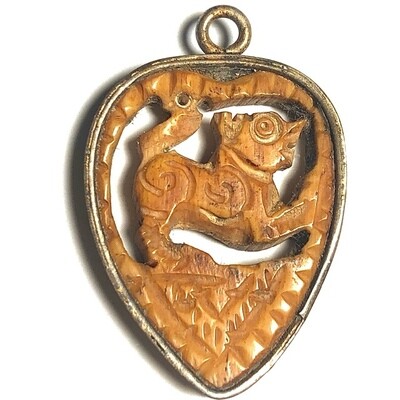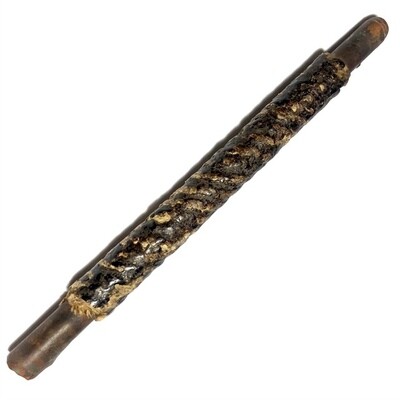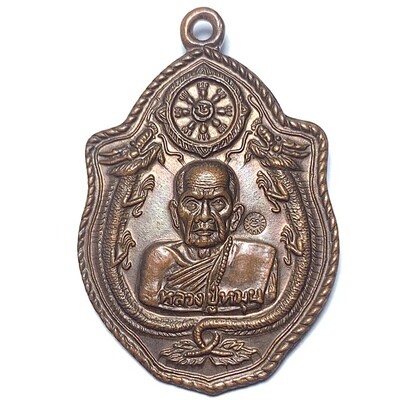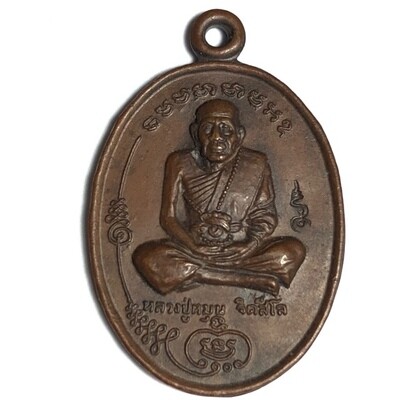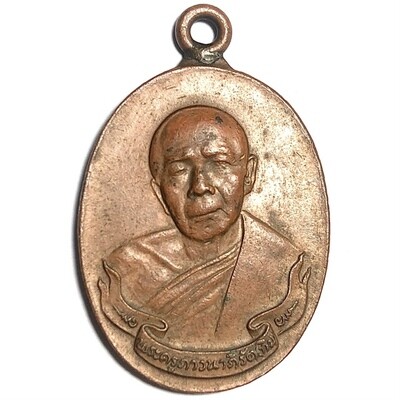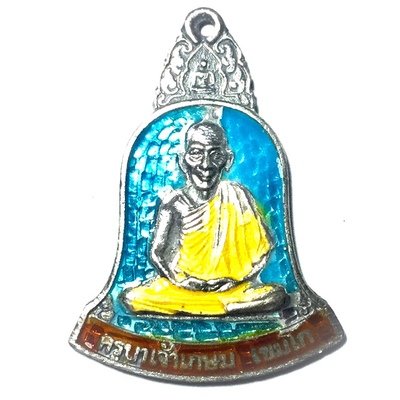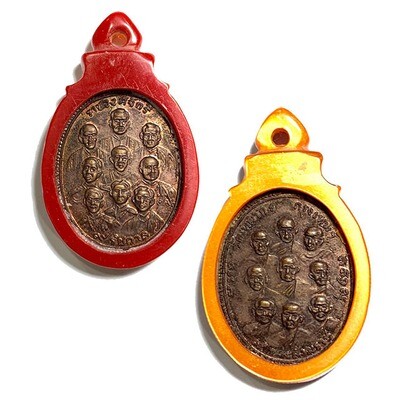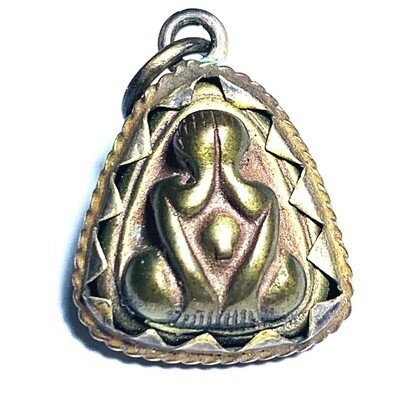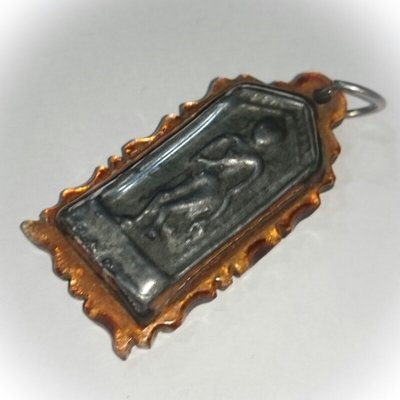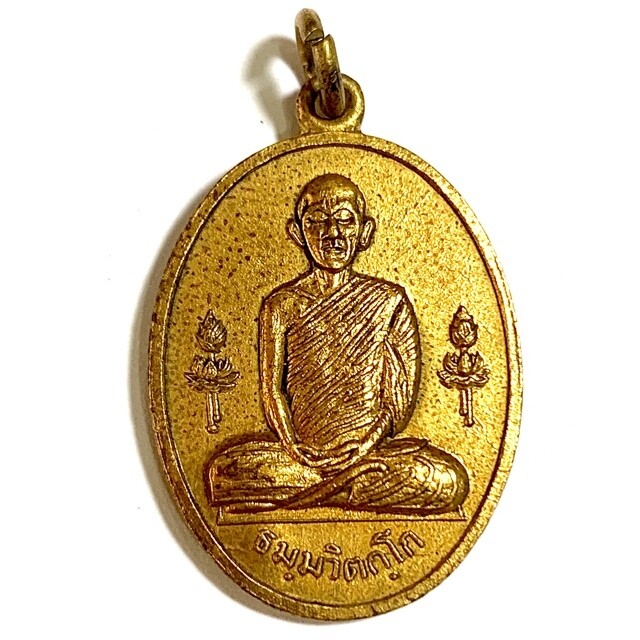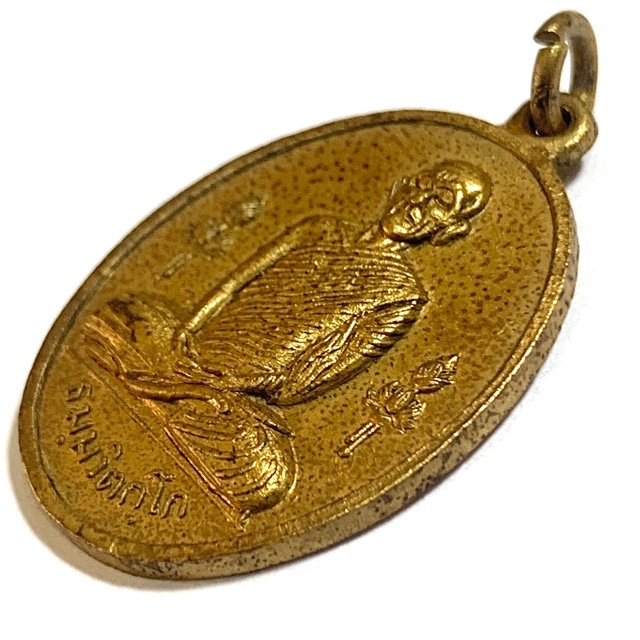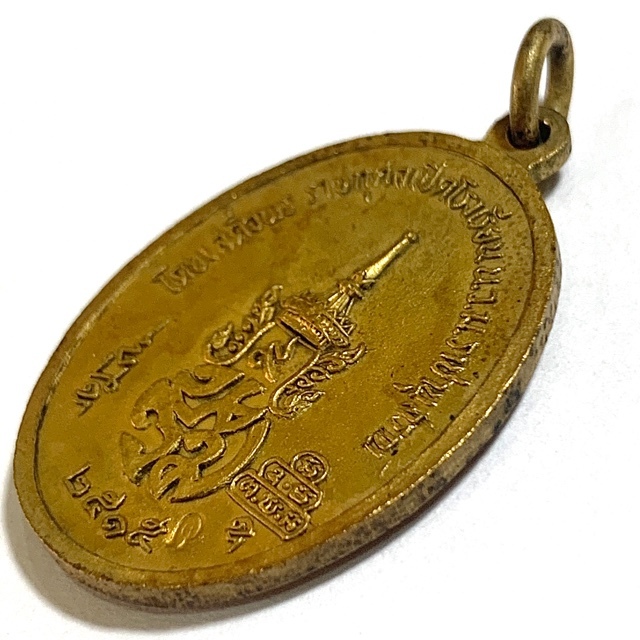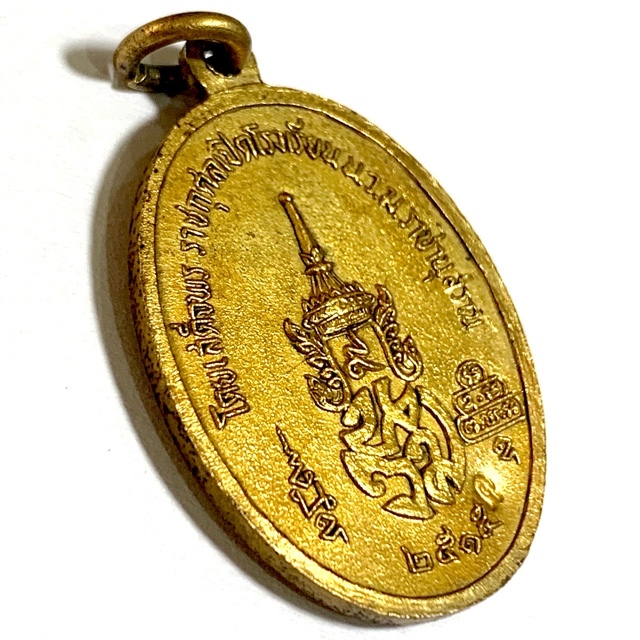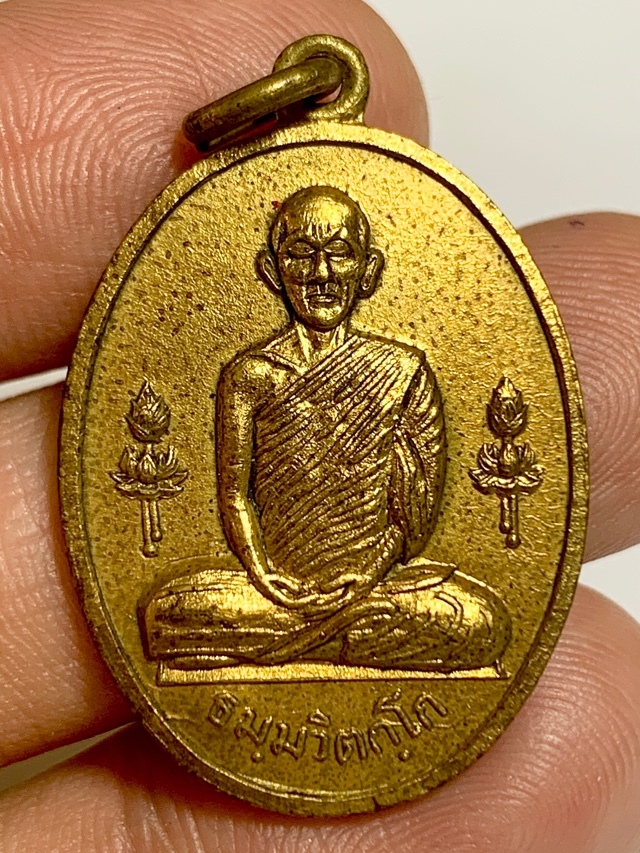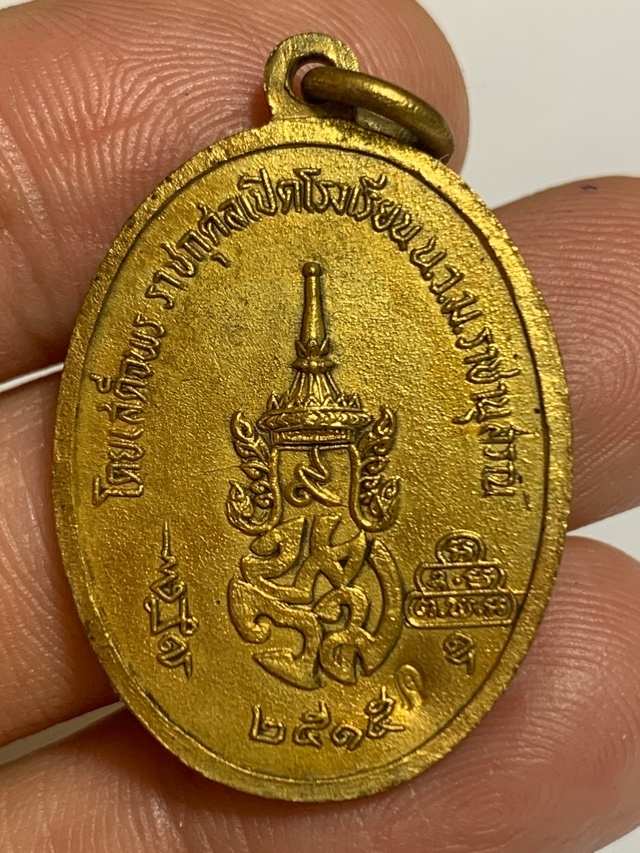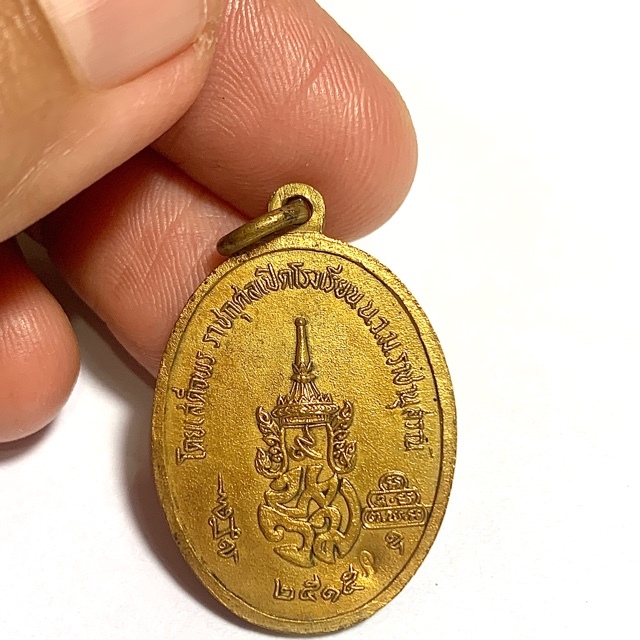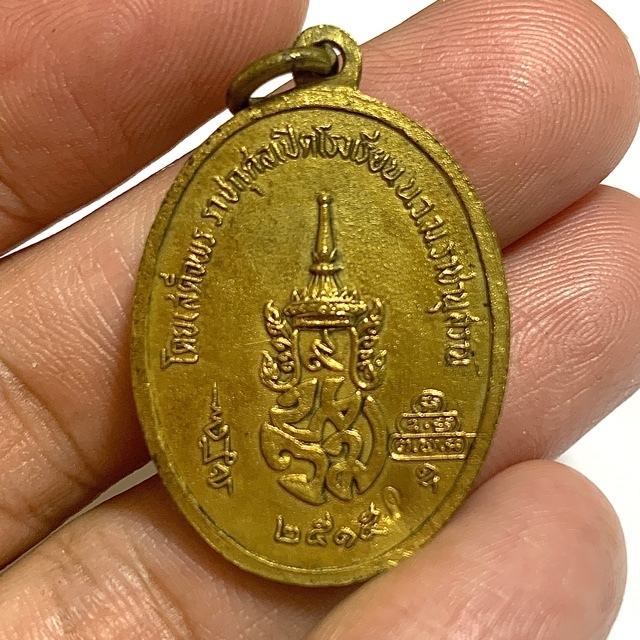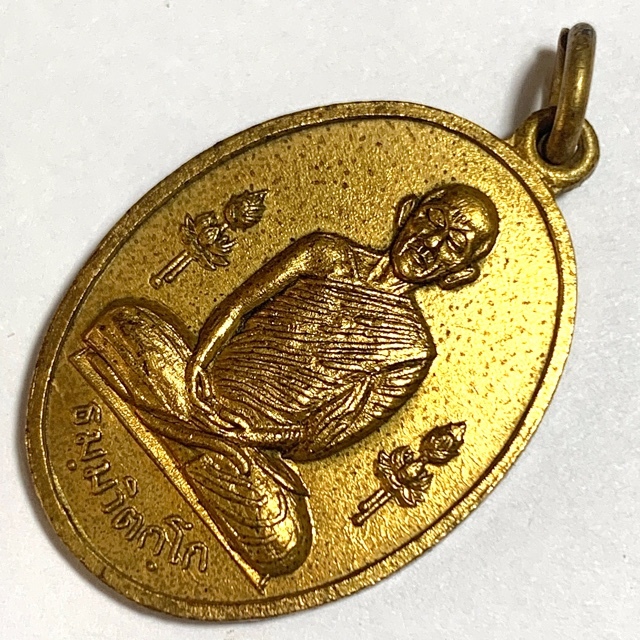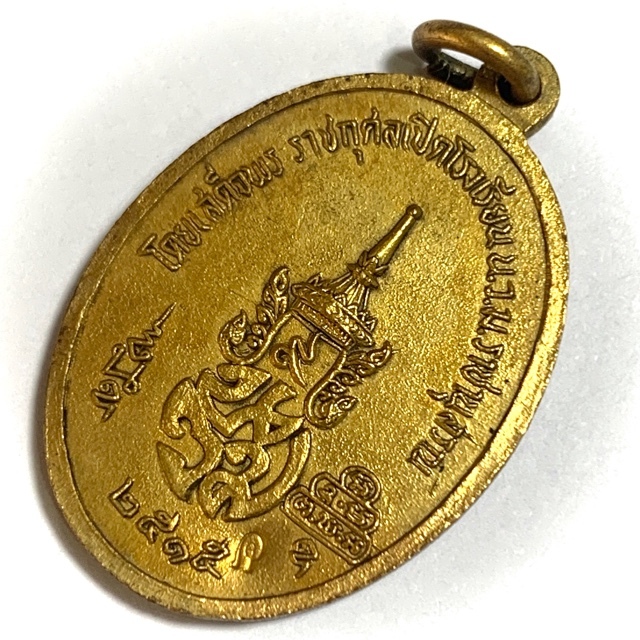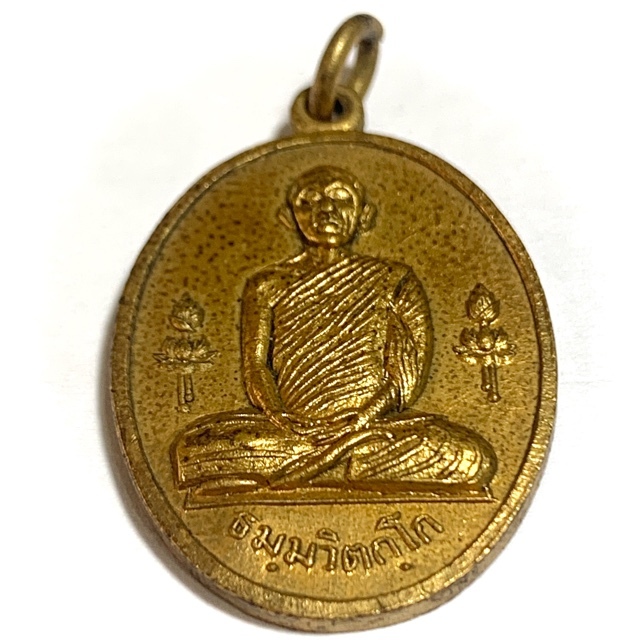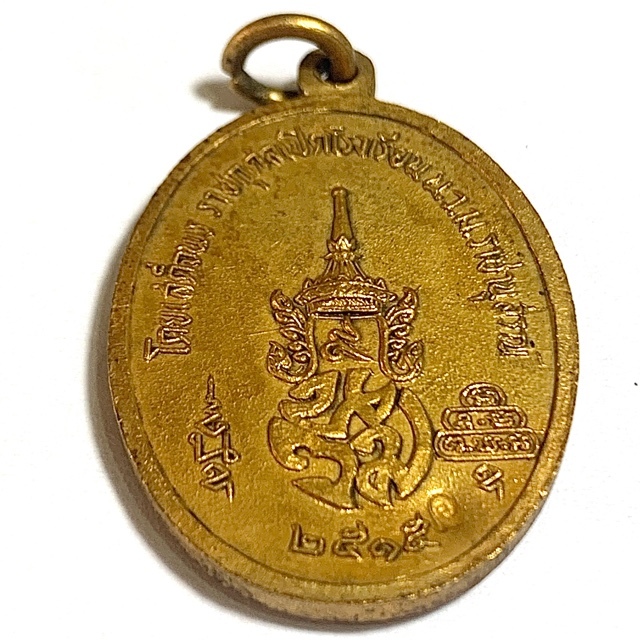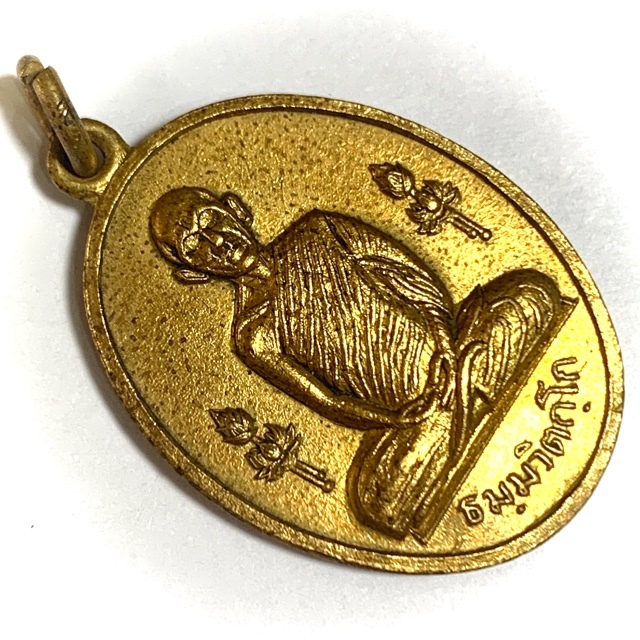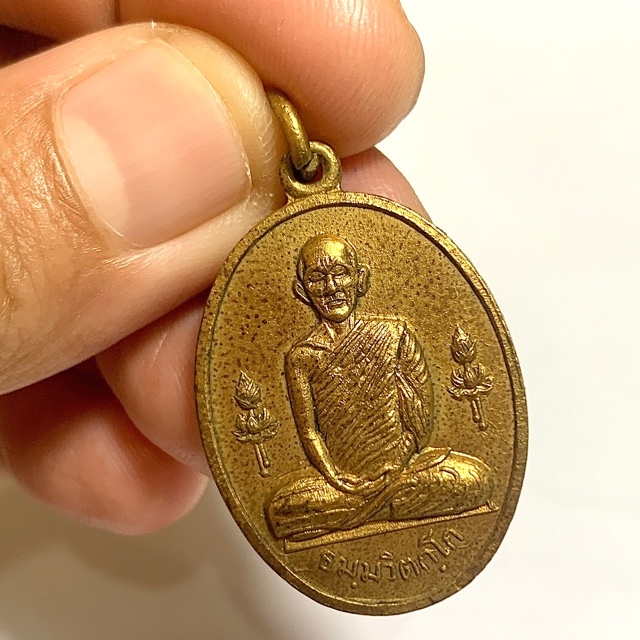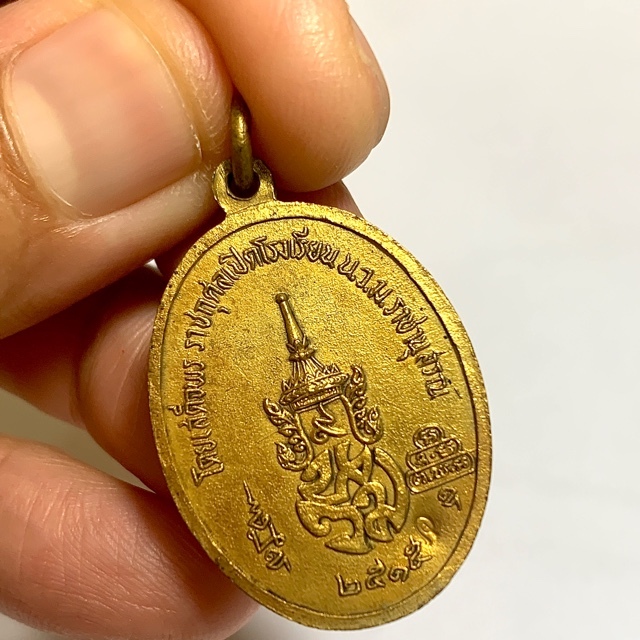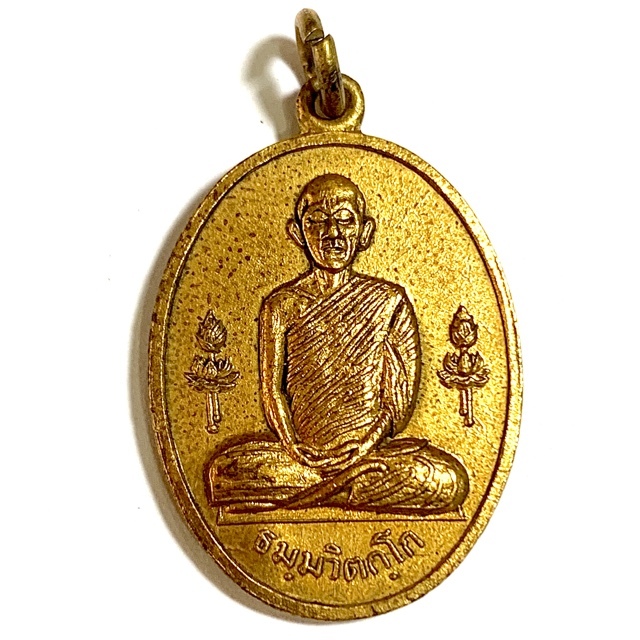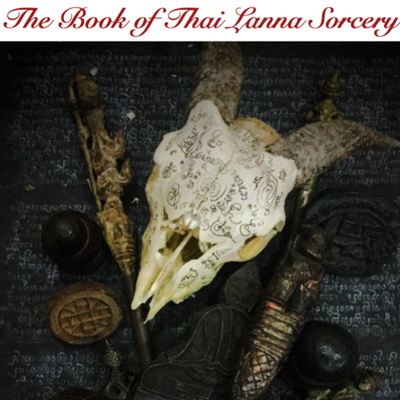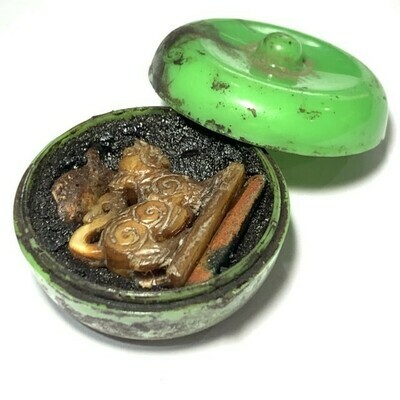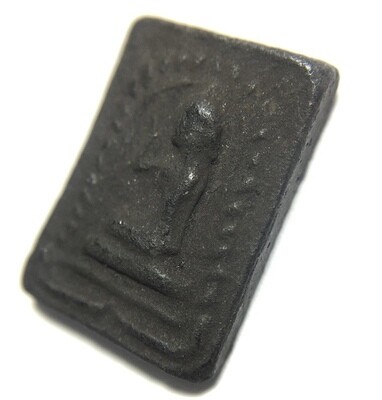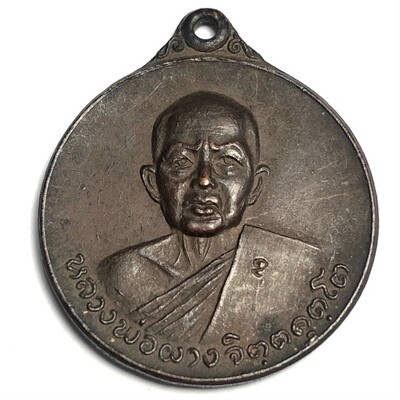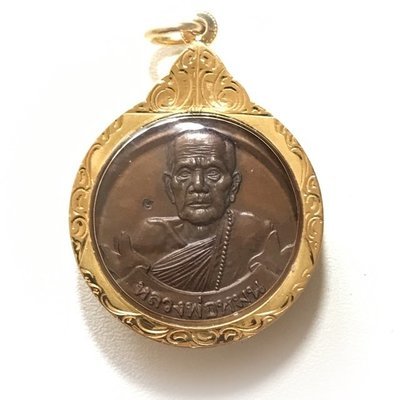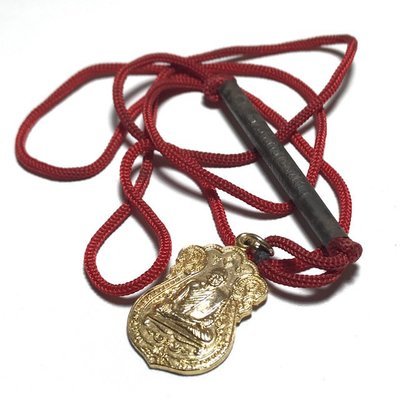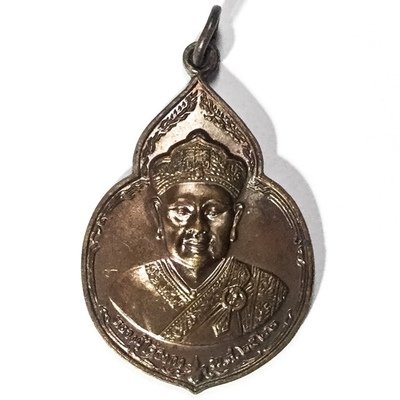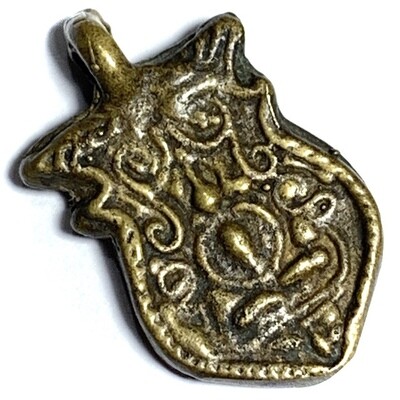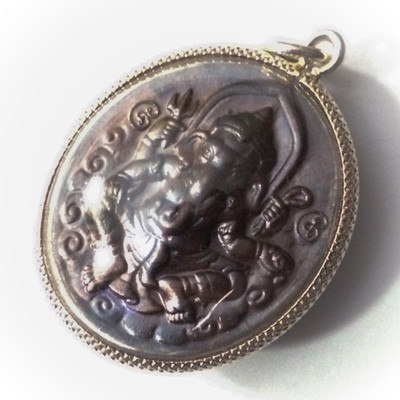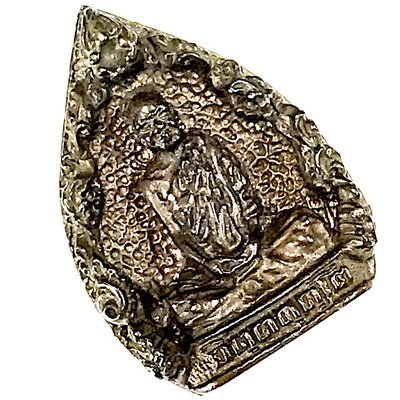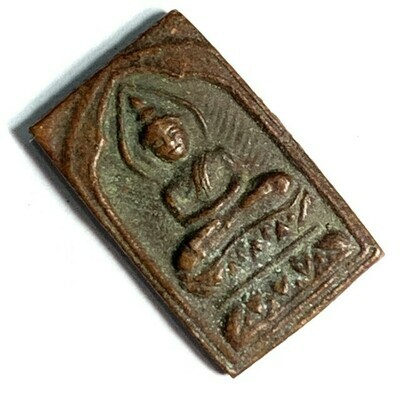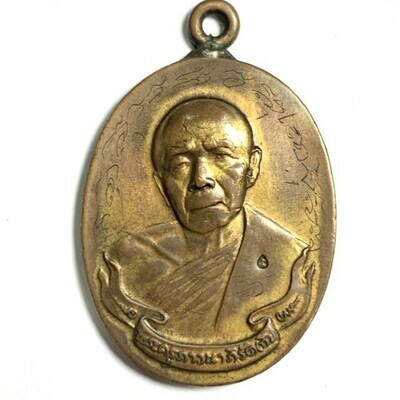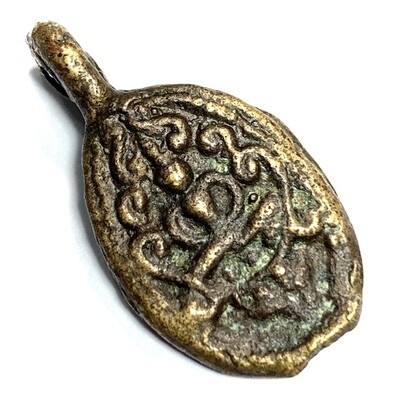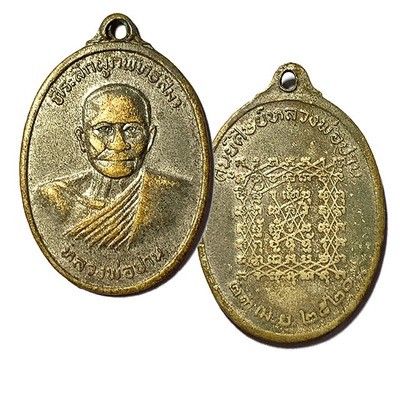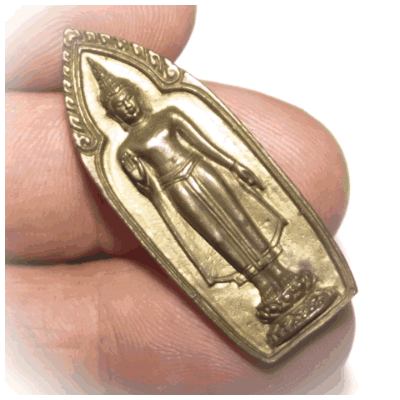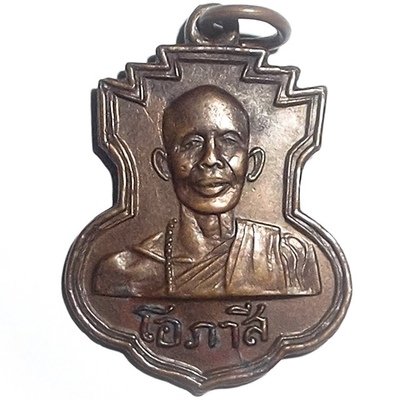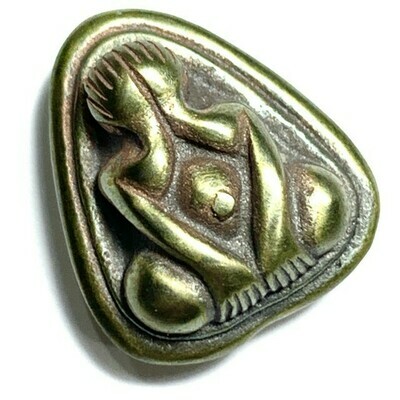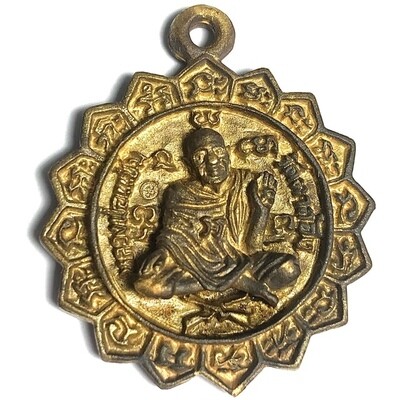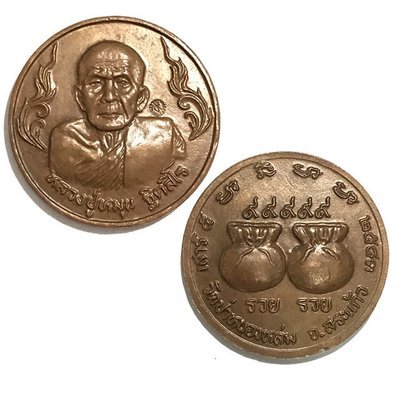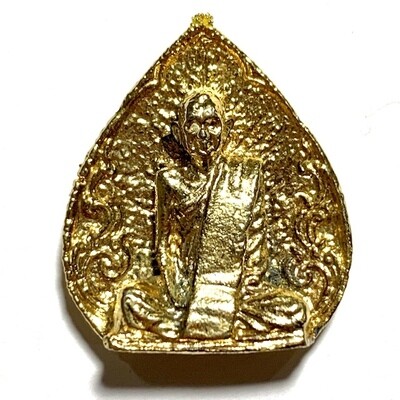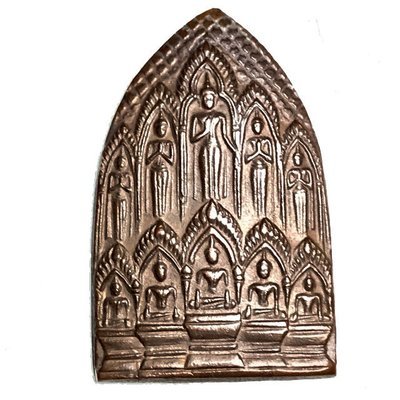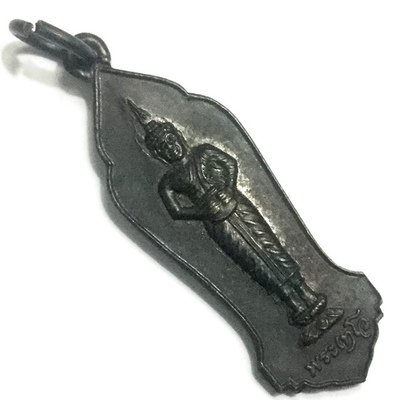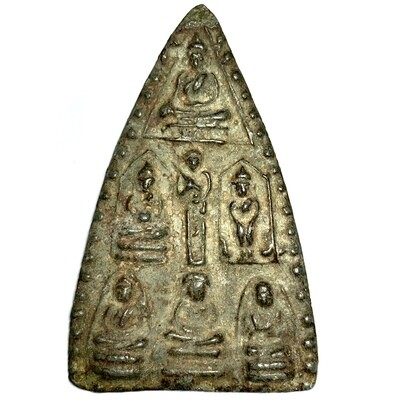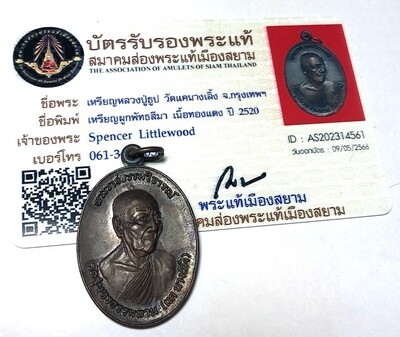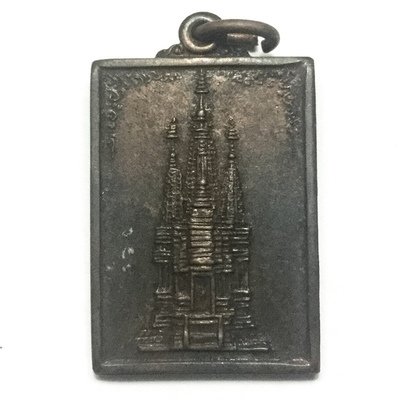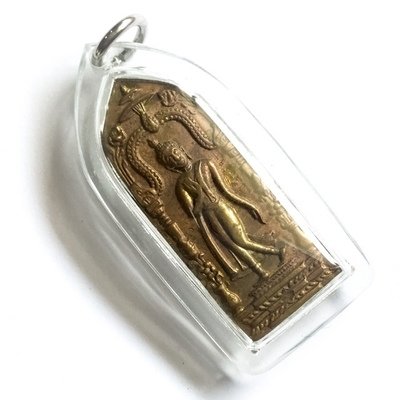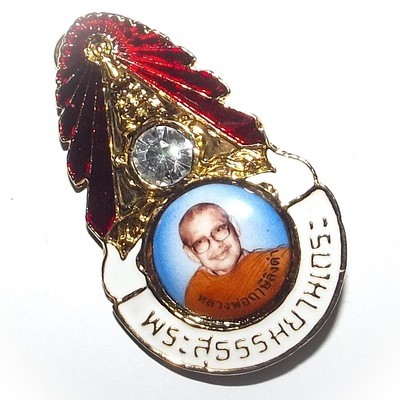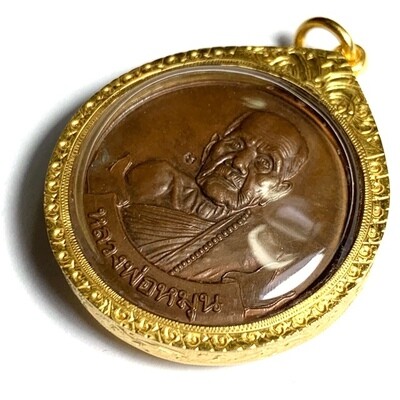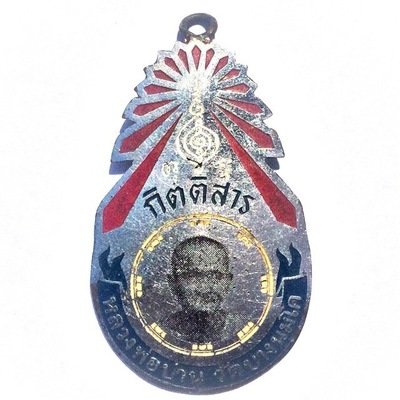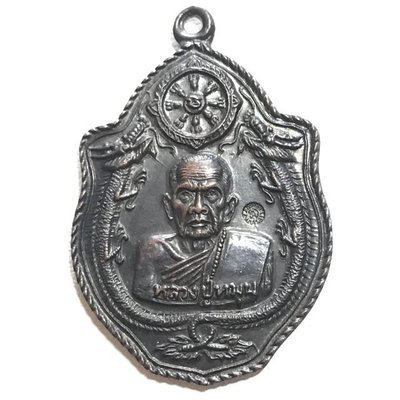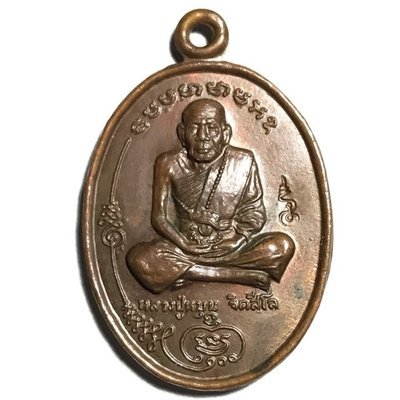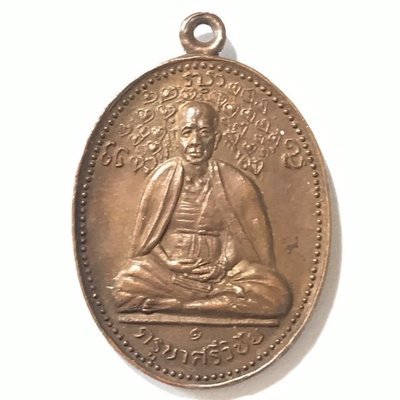A pristinely kept and extremely rare Rian Mangorn Koo Nuea Nava Loha Pim Pised Dtok Sorng Code Ma Wat Pha Nong Lom Run Sao Ha Maha Sethee 5th Lunar Saturday Blessing Ceremony Edition Guru Monk Coin, released in 2543 BE, to raise funds for the Kuti Songk Monks Huts and improve the facilities at the temple of Wat Pha Nong Lom.
This model of Rian Mangorn Koo twin dragons Monk Coin is a very rare Pim Pised (Niyom preferred) and differs from the majority of Rian Mangorn Koo Wat Pha Nong Lom Edition coins in Nava Loha, because of the double code MA stamp. Most coins of the Nava Loha series made for Wat Pha Nong Lom have only a single code Ma Stamp (on the Sangkati chest sash of the robe of Luang Phu), and only the Pim Pised special models received double code stamps. Only very few (unknown number) were distributed with double code stamp, making this not only a sacred, powerful master class amulet, but also a rare collectors piece.
The Rian Mangorn Koo of Luang Phu Hmun is, as are all of his amulets, known for the power of Jaroen Lap Wealth Increasement, and Lucky Fortunes, as well as for their Miraculous Protective Powers. Those born in the year of the dragon love to Bucha this amulet especially, for the obvious reason of the double dragon guardians.
For those with lower budgets, who seek power above collectability and rarity, we recommend to seek the Rian Mangorn Nuea Tong Daeng or Nava Loha single Code Ma, of the same edition, which carries a lower price than this special Nava Loha Pim Pised Gammagarn double code collectors edition model.
Rian Jao Khun Nor Bua Sorng Khang 2515 BE Nuea Galai Tong Blessed by Luang Phu Tim of Wat Laharn Rai
Rian Jao Khun Nor Nor Wor Mor Dork Bua 2 Khang 2515 BE School Building Edition, Blessed by the Great Late Luang Phu Tim Issarigo, of Wat Laharn Rai, in raytong (world famous for his Pra Khun Phaen Pong Prai Kumarn amulets) This is an extremely fine example of the Rian Roop Khai BE Guru Monk Coin amulet, in Nuea Galai Tong, from the 2515 BE Edition, in the image of, and in reverence and memory the Great Jao Khun Nor, an Arya Sangha Monk of Historical Importance, who maintained a perfect, exemplary, and admirable trajectory of practice in his Patipata as a Buddhist Monk.
This Pim is in Nuea Bronze Chup Galai Tong Sacred Brazen Alloy Galvanized with Gold and Brass. This series was the final edition of this great Master Monk, and included an array of different amulets. This Edition is highly preferred, for the fact that the Great lph Tim presided over the empowerment and Blessing Ceremony, and gave special Empowerments, along with a large array of other Great Master Monks.
Released in Buddha Abhiseka Ceremony at Wat Silakhant in the year 2515 BE, to Inaugurate the construction of the Maha Witayalai Nakorn Nayok School Building, with the Great Luang Phu Tim, of Wat Laharn Rai present to perform empowerment . Jao Khun Nor was a Arya Sangha Guru Monk whose Magical Powers as far as amulets are concerned are undisputed, and are known for their Metta Mahaniyom, Maha Lap, Klaew Klaad, and Serm Duang properties.
A most recommendable amulet for the Family Heirloom Collection, and to Wear, with no black magic, and pure Buddhakun Blessings. Increase Wealth and Treasures and Klaew Klaad Protection, Serm Duang (Improve Auspicious Karma). The amulets were made using dried Bai Tong (banana leaf) which Khao Khun Nor would use to place his food on and eat from (used in olden days instead of a plate), in his Kuti Hut, which were mixed with old Muan Sarn Sacred Powders from previous editions of amulets made by Jao Khun Nor, and other Muan Sarn donated by Many Great Masters,
Jao Khun Nor is officially known as 'Tan Tammawidtago Pikhu' or 'Prayan Radtnarachamanidt. He was known for his immense Mercy and Compassion and Sincerity, as well as for his Extreme Diligent Effort and Patience in his Practice of Purity in the Buddhist Vinaya as a Bhikkhu in the Buddha Sasana.
This Edition was released in 2515 BE (1970), this amulet served to fund and celebrate the inauguration of a highly necessary school building for the needy children in Nakhon Nayok province. Design and Symbolism: The amulet, a masterpiece in itself, takes the form of an intricately detailed oval-shaped pendant, commonly referred to as the "Thammawitakko Pikku" amulet. The front side features a sublime depiction of Jao Khun Nor in a seated meditation posture upon a dignified pedestal. The delicate intricacies of the design capture the monk's serene countenance and profound spiritual presence. The monk's image is surrounded by elegant bird patterns on both sides, symbolizing transcendence and spiritual freedom. The meticulous craftsmanship on the front side reveals Jao Khun Nor's tranquil demeanor, serving as an eternal reminder of his teachings and the virtues he embodied.
Muan Sarn (Material Composition): This sacred amulet exists in three distinct materials, each holding its own significance: 1.Gold (109 pieces): A limited number of amulets cast in solid gold, symbolizing purity, enlightenment, and spiritual wealth. 2. Silver (200 pieces): Representing the moon's calming energy, the silver amulets exude an ethereal glow, fostering tranquility and spiritual balance. 3. Bronze with Galai Tong (15,000 pieces): The most abundant version, these amulets embody the monk's teachings in a form accessible to a broader audience, spreading his wisdom far and wide.
Variations (Pim Song): Two variations of the amulet exist, distinguished by the presence or absence of dots in the Thai letters "ม.ม้า" (M.MA) on the front side. While the back side remains uniform for both versions, the subtle differences in the front design add an extra layer of intrigue to these sacred talismans.
Jao Khun Nor, born as Truek Jindanayan, left an indelible mark on Thai Buddhism with his unwavering commitment to virtue and spiritual enlightenment. From his early years of education to military service and eventual entry into the esteemed civil service, Jao Khun Nor's life journey culminated in his renunciation of worldly possessions. The amulet, created to commemorate the inauguration of a school building, embodies the monk's teachings on virtue, compassion, and spiritual mindfulness. It serves as a tangible connection to Jao Khun Nor's profound impact on Thai society and the enduring legacy he left behind.

Jao Khun Nor was born on the 5th february 2440 BE, close to the temple of Wat Somanas Voraviharn in Bangkok with Somdej Pra Putta Kosajarn (Luang Por Jaroen) as his Upachaya. . He Ordained into the Buddhist sangha in the Year 2468 BE, and because Extremely revered for his Immense Patience, Diligent Efforts, and Merciful Personality. His selflessness was highly noticeable, and his trajectory led him to become one of the most highly revered and respected Monks in the whole Nation, both by Devotees, and amongst his Peers in the Sangha.
His Merits were often Lauded by other Great Monks of the Time, whose admiration for Jao Khun Nor was often publicly stated. The presence of the Great Masters in his amulet Blessings is further proof of how the other Great Monks of the Sangha respected the Great Jao Khun Nor.
Jao Khun Nor died in the year 2514 BE at the age of 74, after 56 years of Diligent Service as an Ordained Monk. He passed away after suffering a long time from a terrible cancer on his neck, which he suffered throughout his final time, but which disappeared just before his death, and which was an extremely large protuberance with a very painful open wound.
But Tan Jao Khun Nor still went to every morning and evening prayer chanting of the Uposadha Chapel and would sit and give Dhamma sermons as usual, and never once showed that he was in pain in front of the Devotees, which is unimaginable to any normal Human Being.
Above, a picture of the Great Monk Jao Khun Nor, during the time he suffered with extreme throat cancer, but remained practicing as usual without fail, maintaining complete diligence, without taking a rest. The open wound of the Cancer disappeared before his death, despite the fact that he refused any special treatment apart from letting Dr. paibun clean it regularly (after which he would always give blessings to everybody chanting the Chinabanjara Kata). He said 'The wound came by itself, and so, it should also leave by itself.
Before he passed away, he performed the blessing and empowerment of sacred earths and gravels, which he called 'Pra Por Mae Torani Bpatawi Dhatu' which means 'Mother and Father Dharani Earth Mother Elemental Relics', which are considered extremely powerful. He was reputed to say to Devotees that if they were to remember him, they should think of him by his Dhamma name of 'Tammawidtago', which means to think of the Dhamma, or 'Dtreuk Therng Pra Tam'.
This also means to think of the Dhamma (His birth Name was 'Dtreuk'). If we analyse this, we can see that he was leading his devotees to think of the Triple Gem and always be Mindful of it, which is of course the best form of spiritual 'self protection' through mindful practice of Dhamma, and Avoidance of Wrongdoing.

Above : The Pra Por Mae Torani Bpatawi Dhatu Relics of Jao Khun Nor
It was said by the Sangkaracha Royal Monk who was also the Upachaya (ordaining officer) of Jao Khun Nor, that "this is not any ordinary person. He is already a Noble Person (one of the four kinds of Enlightened Beings). In addition, The Great Luang Ta Maha Bua was known to have said that Jao Khun Nor was a 'Pra Arahant Klang Krung' declaring him an Enlightened Arahant.
Use the Traditional Thai Buddhist Method for Bucha;
1. Chant Maha Namasakara (3 Times)
2. Chant the Trai Soranakom (3 Times)
3. Chant Kata Aaraatanaa Pra Krueang (3 Times)
Kata Maha Namasakara
Namo Dtat-Sa Pakawa-Dto Araha-Dto Sam-Maa Sam-Put-Dtat-Sa
Namo Dtat-Sa Pakawa-Dto Araha-Dto Sam-Maa Sam-Put-Dtat-Sa
Namo Dtat-Sa Pakawa-Dto Araha-Dto Sam-Maa Sam-Put-Dtat-Sa
Above : Scared Muan Sarn Pong Wised powders are inserted into the hollow hoilow in the base of the amulet.
Trai Soranakom
Puttang Cheewidtang Yaawa Nipaanang Saranang Kajchaami
Tammang Cheewidtang Yaawa Nipaanang Saranang Kajchaami
Sangkang Cheewidtang Yaawa Nipaanang Saranang Kajchaami
Tudtiyambpi Puttang Cheewidtang Yaawa Nipaanang Saranang Kajchaami
Tudtiyambpi Tammang Cheewidtang Yaawa Nipaanang Saranang Kajchaami
Tudtiyambpi Sangkang Cheewidtang Yaawa Nipaanang Saranang Kajchaami
Dtadtiyambpi Puttang Cheewidtang Yaawa Nipaanang Saranang Kajchaami
Dtadtiyambpi Tammang Cheewidtang Yaawa Nipaanang Saranang Kajchaami
Dtadtiyambpi Sangkang Cheewidtang Yaawa Nipaanang Saranang Kajchaami
Above : Yant Ongk Pra Yantra on rear face of amulet, with Kata 'Tamma Widtago' underneath, which is the Name of Jao Khun Nor in Khom Pali Agkhara script
Kata Aaraatana Pra Krueang
Puttang Aaraatanaanang
Tammang Aaraatanaanang
Sangkang Aaraatanaanang
Puttang Prasittimae
Tammang Prasittimae
Sangkang Prasittimae
Above : a picture of the Great Monk Jao Khun Nor as he suffered with extreme throat cancer, but remained practicing as usual without fail, maintaining complete diligence, without taking a rest.
